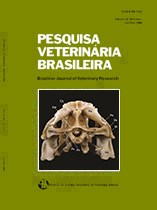 |
|
|
|
Year 2014 - Volume 34, Number 1001
|

|
Mode B ultrasonography and abdominal Doppler in crab-eating-foxes (Cerdocyon thous), 34(Supl.1):23-28
|
ABSTRACT.- Silva A.S.L., Feliciano M.A.R., Motheo T.F., Oliveira J.P., Kawanami A.E., Werther K., Palha M.D.C. & Vicente W.R.R. 2014. Mode B ultrasonography and abdominal Doppler in crab-eating-foxes (Cerdocyon thous). Pesquisa Veterinária Brasileira 34(Supl.1):23-28. Setor de Animais Selvagens Faculdade de Ciências Agrária e Veterinárias, Universidade Estadual Paulista, Via de acesso Professor Paulo Donato Castellane s/n, Jaboticabal, SP 14884-900, Brazil. E-mail: alannalima@gmail.com
Annually hundreds of crab-eating foxes (Cerdocyon thous) are referred to rehabilitation centers and zoos in Brazil. The ultrasonographic study of wildlife species is an important tool for a non-invasive and accurate anatomical description and provides important information for wildlife veterinary care. The aim of the present study was to determine the characteristics of the main abdominal organs as well as the vascular indexes of the abdominal aorta and renal arteries of crab-eating foxes (Cerdocyon thous) using mode B ultrasonography and Doppler ultrasonography, respectively. Ultrasonographic features of the main abdominal organs were described and slight differences were noticed between ultrasound imaging of abdominal organs of crab-eating foxes and other species. The bladder presented wall thickness of 12±0.01mm, with three defined layers. Both, the right and left kidneys presented corticomedullary ratio of 1:1 and similarly to the adrenals and the liver, they were homogeneous and hypoechoic compared to the spleen. The spleen was homogeneous and hyperechoic compared to the kidneys. The stomach presented 3 to 5 peristaltic movements per minute, wall thickness of 39±0.05mm and lumen and mucosa with hyperechoic and hypoechoic features, respectively. Small and large intestines presented 2 to 3 peristaltic movements per minute, wall thickness of 34±0.03mm and three defined layers with hyperechogenic (submucosa and serosa) and hypoechogenic (muscular) features. Ovaries of the female crab-eating fox were hypoechoic compared to the spleen and with heterogeneous parenchyma due to the presence of 2x2mm ovarian follicles. Prostates of the six males were regular and with a well defined boundary, with a homogeneous and hyperechoic parenchyma compared to the spleen. Vascular indexes of the abdominal aorta (PSV: 25.60±0.32cm/s; EDV: 6.96±1.68cm/s; PI: 1.15±0.07 e RI: 0.73±0.07) and right (PSV: 23.08±3.34cm/s; EDV: 9.33±2.36cm/s; PI: 1.01±0.65 e RI: 0.65±0.16) and left renal arteries (PSV: 23.74±3.94cm/s; EDV: 9.07±3.02cm/s; PI: 1.04±0.31 e RI: 0.64±0.10) were determined. Thus, conventional and Doppler ultrasonographic imaging provides basic information that can be used as reference for the species as well for other wild canids and it is a precise and non-invasive method that can be safely used to evaluate and diagnose abdominal injuries in these patients. |
| |
|
|
| |
|
 |